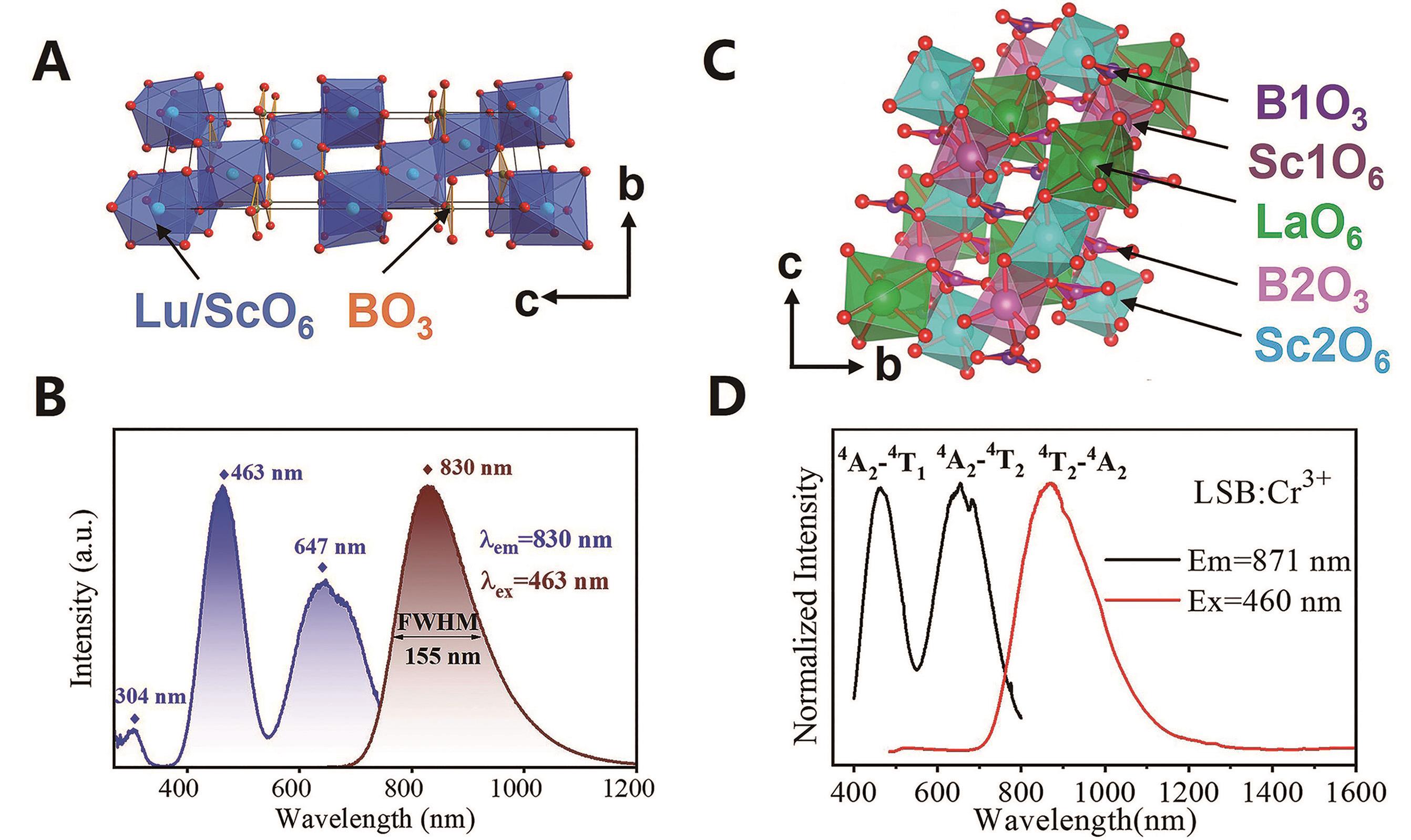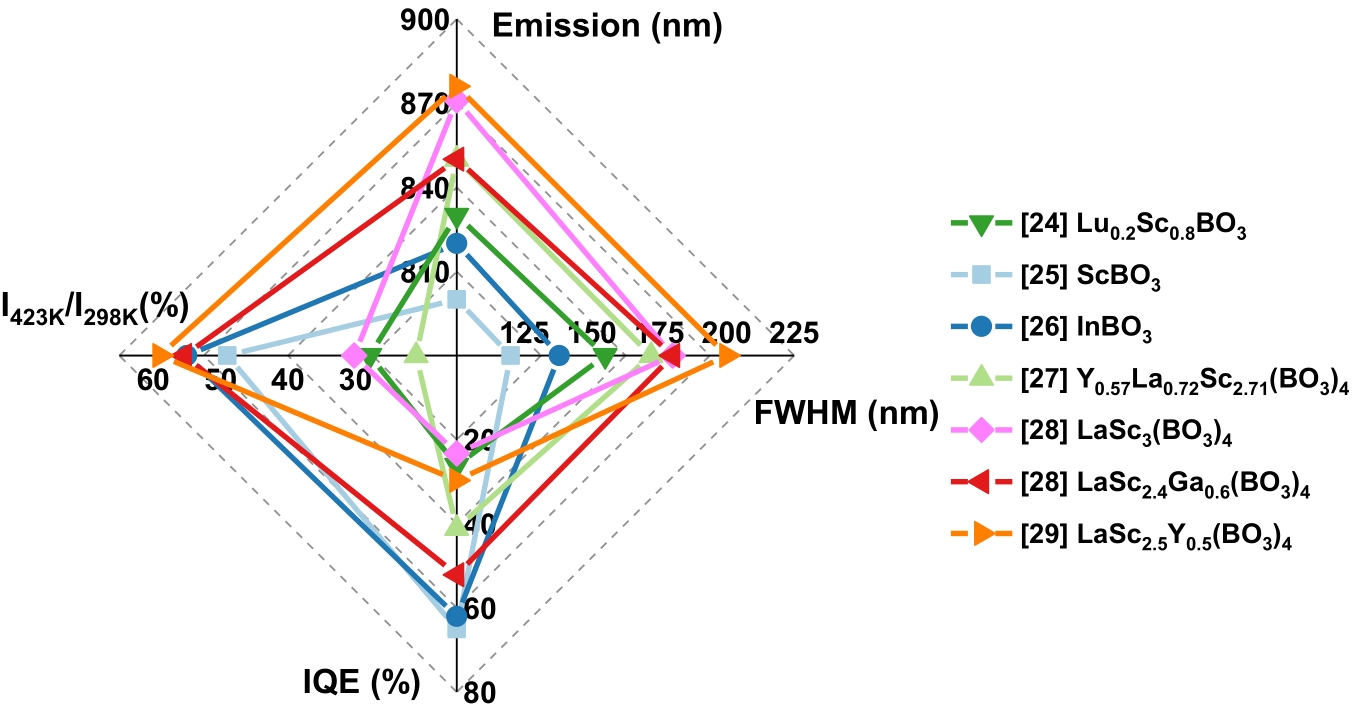
Chinese Journal of Applied Chemistry ›› 2024, Vol. 41 ›› Issue (3): 328-339.DOI: 10.19894/j.issn.1000-0518.230288
• Rare Earth • Previous Articles
Progress on Cr3+-Doped Broadband Near-Infrared Phosphors
Zi-Wei LU1,2, Yong-Fu LIU1( ), Zhao-Hua LUO1, Peng SUN1, Jun JIANG1(
), Zhao-Hua LUO1, Peng SUN1, Jun JIANG1( )
)
- 1.Ningbo Institute of Materials Technology & Engineering,Chinese Academy of Sciences,Ningbo 315201,China
2.School of Materials Science and Chemical Engineering,Ningbo University,Ningbo 315211,China
-
Received:2023-09-22Accepted:2023-12-11Published:2024-03-01Online:2024-04-09 -
Contact:Yong-Fu LIU,Jun JIANG -
Supported by:the National Natural Science Foundation of China(12074393);the Zhejiang Provincial Natural Science Foundation of China(LZ23A040001);the Youth Innovation Promotion Association Chinese Academy of Sciences(2021295)
CLC Number:
Cite this article
Zi-Wei LU, Yong-Fu LIU, Zhao-Hua LUO, Peng SUN, Jun JIANG. Progress on Cr3+-Doped Broadband Near-Infrared Phosphors[J]. Chinese Journal of Applied Chemistry, 2024, 41(3): 328-339.
share this article
Add to citation manager EndNote|Ris|BibTeX
URL: http://yyhx.ciac.jl.cn/EN/10.19894/j.issn.1000-0518.230288
| Phosphors | λex/nm | λem/nm | FWHM/nm | IQE/% | EQE/% | I423 K/I298 K (%) | Ref. |
|---|---|---|---|---|---|---|---|
| KAlP2O7∶Cr3+ | 450 | 790 | 120 | 78.9 | 31.1 | 77 | [ |
| NaAlP2O7∶Cr3+ | 450 | 790 | 121 | 49.7 | 14.6 | 80.6 | [ |
| NaGaP2O7∶Cr3+ | 460 | 793 | 115 | 56.4 | 25.89 | 85.45 | [ |
| KGaP2O7∶Cr3+ | 455 | 815 | 125 | 55.8 | 36.6 | 68 | [ |
| KGaP2O7∶Cr3+ | 460 | 815 | 127 | 74.4 | 33.3 | 56 | [ |
| LiGaP2O7∶Cr3+ | 452 | 846 | 168 | 47.8 | 28.3 | ~23 | [ |
| LiInP2O7∶Cr3+ | 460 | 860 | 165 | 19.5 | 9.36 | ~22 | [ |
| NaInP2O7∶Cr3+ | 480 | 870 | 150 | 28.2 | 14.05 | 20 | [ |
| KScP2O7∶Cr3+ | 470 | 870 | 153 | / | / | ~13 | [ |
| KInP2O7∶Cr3+ | 473 | 880 | 163 | / | / | 40 | [ |
| LiScP2O7∶Cr3+ | 470 | ~880 | 170 | 38 | 20 | ~20 | [ |
| KLuP2O7∶Cr3+ | 480 | 900 | 178 | / | / | 5 | [ |
| NaScP2O7∶Cr3+ | 472 | 910 | 200 | 14.9 | / | / | [ |
| ScBO3∶Cr3+ | 460 | 800 | 120 | 65 | / | 49 | [ |
| InBO3∶ Cr3+ | 480 | 820 | 138 | 62 | / | 55 | [ |
| CeSc3(BO3)4∶Cr3+ | 471 | 822 | / | 65.8 | 16.05 | / | [ |
| Lu0.2Sc0.8BO3∶Cr3+ | 463 | 830 | 155 | 26.1 | / | 27.90 | [ |
| Y0.57La0.72Sc2.71(BO3)4∶Cr3+ | 466 | 850 | 172 | 41.1 | / | ~21 | [ |
| LaSc2.4Ga0.6(BO3)4∶Cr3+ | 460 | 850 | ~180 | 52.12 | / | 55.35 | [ |
| LaSc3(BO3)4∶Cr3+ | 460 | 871 | ~180 | 23.29 | / | 30.2 | [ |
| LaSc2.5Y0.5(BO3)4∶Cr3+ | 467 | 876 | ~200 | 29.7 | / | ~59 | [ |
| LaSc1.2Ca0.9Si0.9(BO3)4∶Cr3+ | 469 | 880 | ~200 | / | / | 52.68 | [ |
| CaMgSi2O6∶Cr3+ | 455 | ~800 | ~150 | 77.50 | 21.60 | ~92 | [ |
| LiInSi2O6∶Cr3+ | 460 | 840 | 143 | 75 | - | ~77 | [ |
| Mg2Ge2O6∶Cr3+ | 454 | 844 | ~172 | 65.4 | 28.5 | ~33 | [ |
| CaMgGe2O6∶Cr3+ | 450 | 845 | 160 | 84 | 30 | >50 | [ |
| LiScSi2O6∶Cr3+ | 460 | 845 | 156 | 64.4 | 33.4 | 75 | [ |
| NaScSi2O6∶Cr3+ | 480 | 860 | 149 | 22.2 | 10.2 | 69 | [ |
| (Mg0.6Li0.4)(Mg0.6Sc0.4)Ge2O6∶Cr3+ | 460 | 874 | ~182 | 66.6 | 31.5 | ~42 | [ |
| Li(Ga0.24Sc0.7)Ge2O6∶6%Cr3+ | 470 | 875 | 192 | 70.6 | 47.9 | 32 | [ |
| NaSc(Si1.8Ge0.2)O6∶Cr3+ | 470 | ~875 | / | / | / | 60 | [ |
| LiInGe2O6∶Cr3+ | 460 | 880 | 172 | 81.2 | 39.8 | ~30 | [ |
| LiIn(Si0.7Ge1.3)O6∶Cr3+ | 470 | 881 | 185 | / | / | ~32 | [ |
| LiScGe2O6∶Cr3+ | 480 | 886 | 160 | 72.6 | 39.9 | <41.9 | [ |
| NaScGe2O6∶Cr3+ | 490 | 895 | 162 | 40.22 | / | ~20.5 | [ |
| NaInGe2O6∶Cr3+ | 480 | 900 | 173 | 34 | / | ~25 | [ |
| CaScAlSiO6∶Cr3+ | 460 | 950 | 205 | 21 | / | ~28 | [ |
| CaSc0.85Al1.15SiO6∶Cr3+ | 460 | 950 | / | 30 | 9 | ~52 | [ |
| GaTaO4∶Cr3+ | 460 | 840 | 140 | 91.2 | 31.3 | 60 | [ |
| ScF3∶Cr3+ | 468 | 853 | 140 | 45 | / | 85.5 | [ |
| Ca2LaZr2Ga2.8Al0.2O12∶Cr3+ | 450 | 820 | 160 | 58.3 | 23.5 | 64 | [ |
| La2MgZrO6∶Cr3+ | 460 | 825 | 210 | ~58 | / | / | [ |
Table 1 λex, λem, FWHM, IQE, EQE and I423 K/I298 K of phosphates, borates, pyroxenes and other phosphors
| Phosphors | λex/nm | λem/nm | FWHM/nm | IQE/% | EQE/% | I423 K/I298 K (%) | Ref. |
|---|---|---|---|---|---|---|---|
| KAlP2O7∶Cr3+ | 450 | 790 | 120 | 78.9 | 31.1 | 77 | [ |
| NaAlP2O7∶Cr3+ | 450 | 790 | 121 | 49.7 | 14.6 | 80.6 | [ |
| NaGaP2O7∶Cr3+ | 460 | 793 | 115 | 56.4 | 25.89 | 85.45 | [ |
| KGaP2O7∶Cr3+ | 455 | 815 | 125 | 55.8 | 36.6 | 68 | [ |
| KGaP2O7∶Cr3+ | 460 | 815 | 127 | 74.4 | 33.3 | 56 | [ |
| LiGaP2O7∶Cr3+ | 452 | 846 | 168 | 47.8 | 28.3 | ~23 | [ |
| LiInP2O7∶Cr3+ | 460 | 860 | 165 | 19.5 | 9.36 | ~22 | [ |
| NaInP2O7∶Cr3+ | 480 | 870 | 150 | 28.2 | 14.05 | 20 | [ |
| KScP2O7∶Cr3+ | 470 | 870 | 153 | / | / | ~13 | [ |
| KInP2O7∶Cr3+ | 473 | 880 | 163 | / | / | 40 | [ |
| LiScP2O7∶Cr3+ | 470 | ~880 | 170 | 38 | 20 | ~20 | [ |
| KLuP2O7∶Cr3+ | 480 | 900 | 178 | / | / | 5 | [ |
| NaScP2O7∶Cr3+ | 472 | 910 | 200 | 14.9 | / | / | [ |
| ScBO3∶Cr3+ | 460 | 800 | 120 | 65 | / | 49 | [ |
| InBO3∶ Cr3+ | 480 | 820 | 138 | 62 | / | 55 | [ |
| CeSc3(BO3)4∶Cr3+ | 471 | 822 | / | 65.8 | 16.05 | / | [ |
| Lu0.2Sc0.8BO3∶Cr3+ | 463 | 830 | 155 | 26.1 | / | 27.90 | [ |
| Y0.57La0.72Sc2.71(BO3)4∶Cr3+ | 466 | 850 | 172 | 41.1 | / | ~21 | [ |
| LaSc2.4Ga0.6(BO3)4∶Cr3+ | 460 | 850 | ~180 | 52.12 | / | 55.35 | [ |
| LaSc3(BO3)4∶Cr3+ | 460 | 871 | ~180 | 23.29 | / | 30.2 | [ |
| LaSc2.5Y0.5(BO3)4∶Cr3+ | 467 | 876 | ~200 | 29.7 | / | ~59 | [ |
| LaSc1.2Ca0.9Si0.9(BO3)4∶Cr3+ | 469 | 880 | ~200 | / | / | 52.68 | [ |
| CaMgSi2O6∶Cr3+ | 455 | ~800 | ~150 | 77.50 | 21.60 | ~92 | [ |
| LiInSi2O6∶Cr3+ | 460 | 840 | 143 | 75 | - | ~77 | [ |
| Mg2Ge2O6∶Cr3+ | 454 | 844 | ~172 | 65.4 | 28.5 | ~33 | [ |
| CaMgGe2O6∶Cr3+ | 450 | 845 | 160 | 84 | 30 | >50 | [ |
| LiScSi2O6∶Cr3+ | 460 | 845 | 156 | 64.4 | 33.4 | 75 | [ |
| NaScSi2O6∶Cr3+ | 480 | 860 | 149 | 22.2 | 10.2 | 69 | [ |
| (Mg0.6Li0.4)(Mg0.6Sc0.4)Ge2O6∶Cr3+ | 460 | 874 | ~182 | 66.6 | 31.5 | ~42 | [ |
| Li(Ga0.24Sc0.7)Ge2O6∶6%Cr3+ | 470 | 875 | 192 | 70.6 | 47.9 | 32 | [ |
| NaSc(Si1.8Ge0.2)O6∶Cr3+ | 470 | ~875 | / | / | / | 60 | [ |
| LiInGe2O6∶Cr3+ | 460 | 880 | 172 | 81.2 | 39.8 | ~30 | [ |
| LiIn(Si0.7Ge1.3)O6∶Cr3+ | 470 | 881 | 185 | / | / | ~32 | [ |
| LiScGe2O6∶Cr3+ | 480 | 886 | 160 | 72.6 | 39.9 | <41.9 | [ |
| NaScGe2O6∶Cr3+ | 490 | 895 | 162 | 40.22 | / | ~20.5 | [ |
| NaInGe2O6∶Cr3+ | 480 | 900 | 173 | 34 | / | ~25 | [ |
| CaScAlSiO6∶Cr3+ | 460 | 950 | 205 | 21 | / | ~28 | [ |
| CaSc0.85Al1.15SiO6∶Cr3+ | 460 | 950 | / | 30 | 9 | ~52 | [ |
| GaTaO4∶Cr3+ | 460 | 840 | 140 | 91.2 | 31.3 | 60 | [ |
| ScF3∶Cr3+ | 468 | 853 | 140 | 45 | / | 85.5 | [ |
| Ca2LaZr2Ga2.8Al0.2O12∶Cr3+ | 450 | 820 | 160 | 58.3 | 23.5 | 64 | [ |
| La2MgZrO6∶Cr3+ | 460 | 825 | 210 | ~58 | / | / | [ |
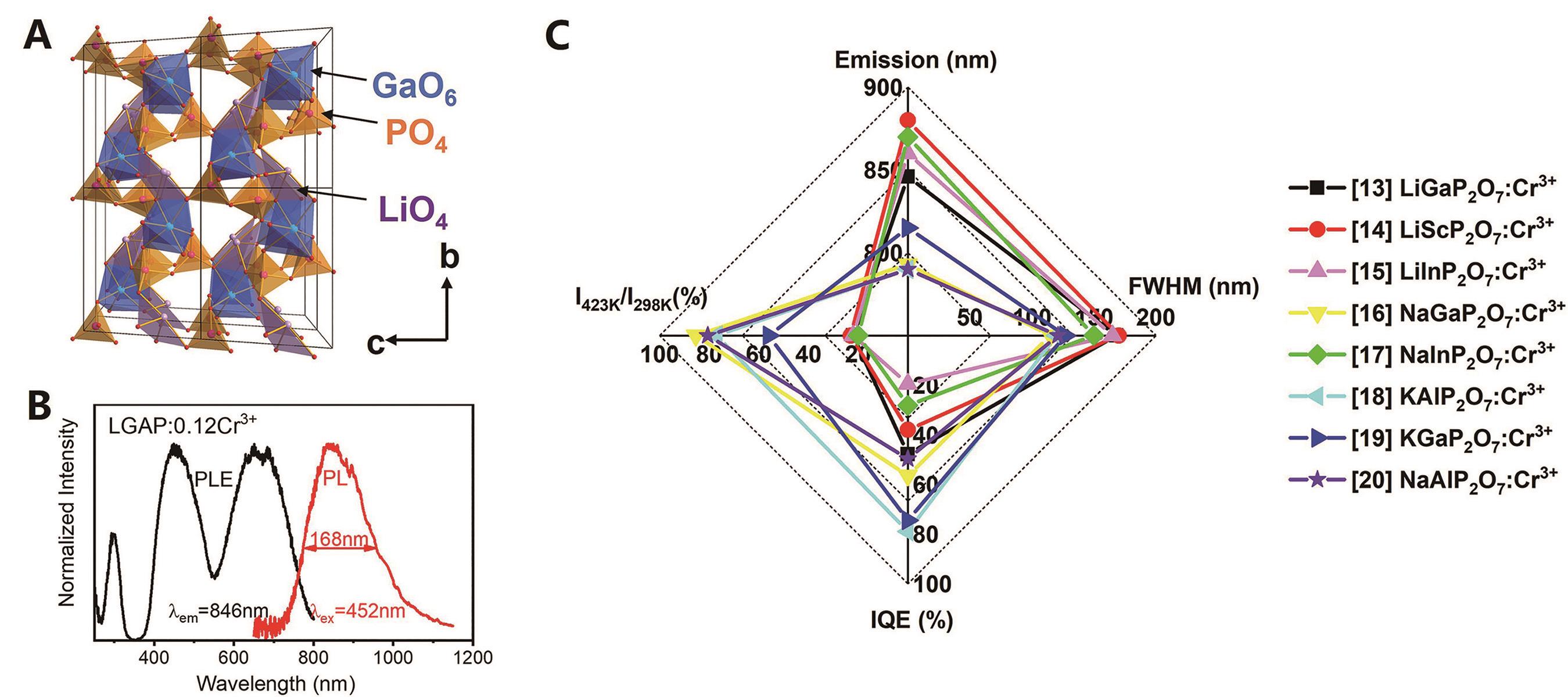
Fig.1 (A) Crystal structure and (B) photoluminescence excitation (PLE) and photoluminescence (PL) spectra of LiGaP2O7∶Cr3+[13]. (C) Radar graph (Emission peak, FWHM, IQE, I423 K/I298 K) of ALnP2O7∶Cr3+ (A=Li, Na, K; Ln=Al, Ga, Sc, In)[13-20]
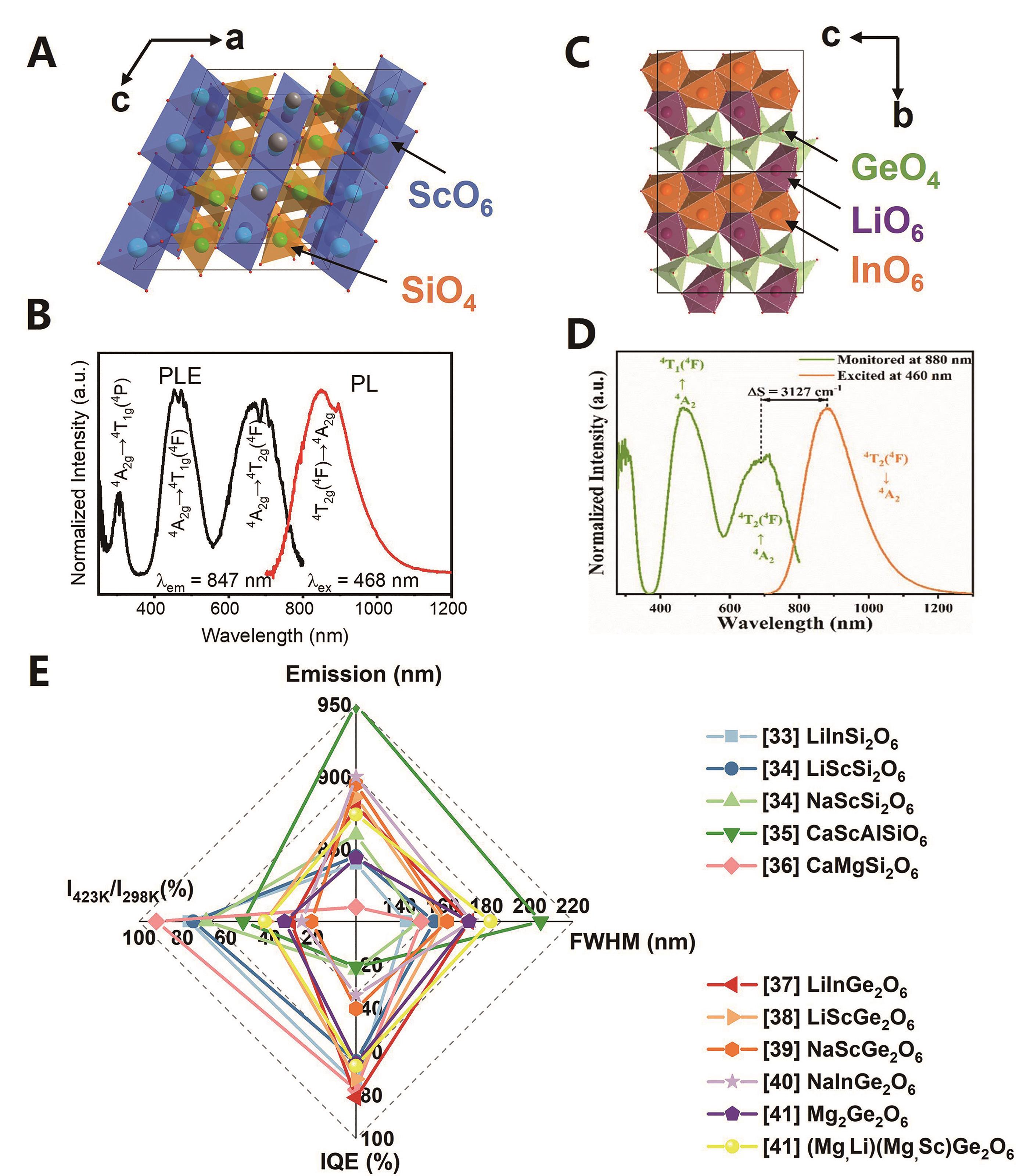
Fig.4 (A) Crystal structure and (B) PLE and PL spectra of LiScSi2O6∶Cr3+[32]; (C) Crystal structure and (D) PLE and PL spectra of LiInGe2O6∶Cr3+[37]; (E) Radar graph (Emission peak, FWHM, IQE, I423 K/I298 K) of ALn(Si,Ge)2O6∶Cr3+ (A=Li, Na, Ca, Mg; Ln=In, Sc, Mg)[33-41]
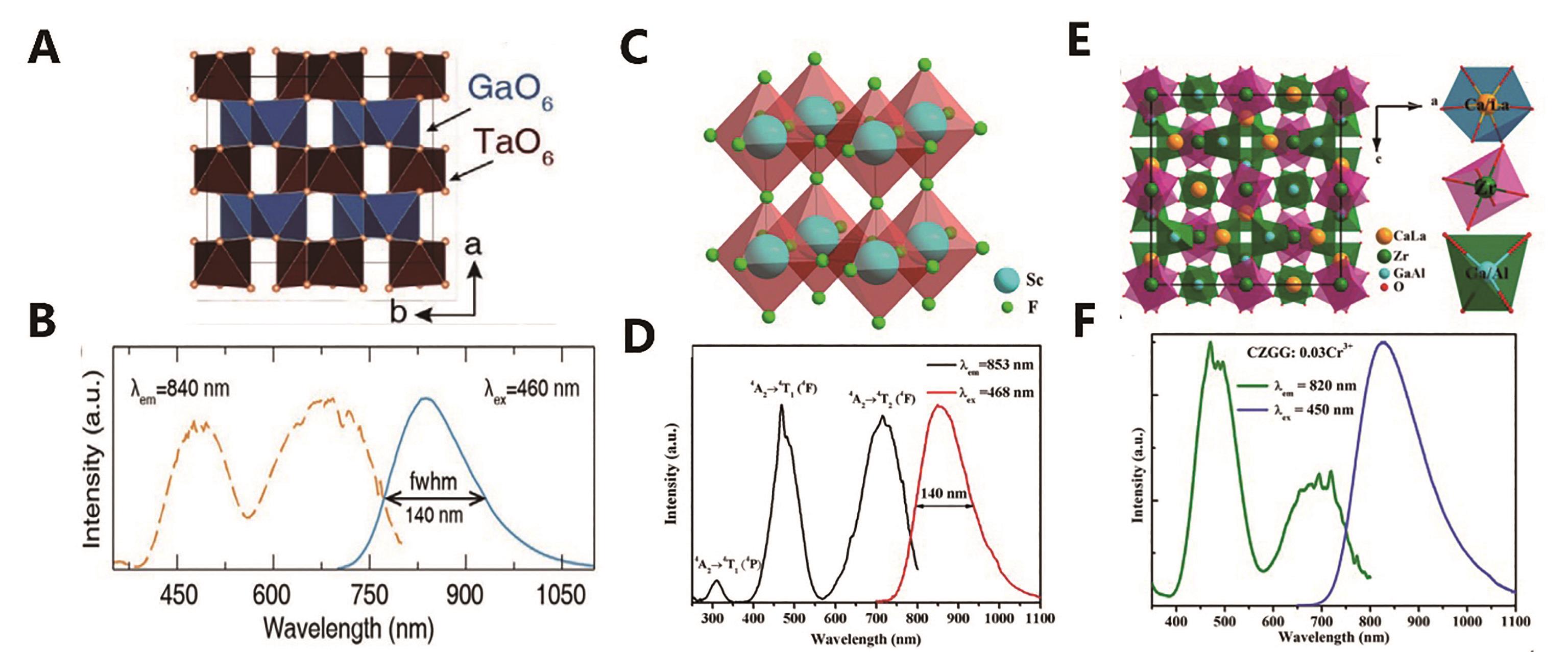
Fig.5 (A) Crystal structure and (B) PL and PLE spectra of GaTaO4∶Cr3+[47]; (C) Crystal structure and (D) PL and PLE spectra of ScF3∶Cr3+[48]; (E) Crystal structure and (F) PL and PLE spectra of Ca2LaZr2Ga2.8Al0.2O12∶Cr3+[49]
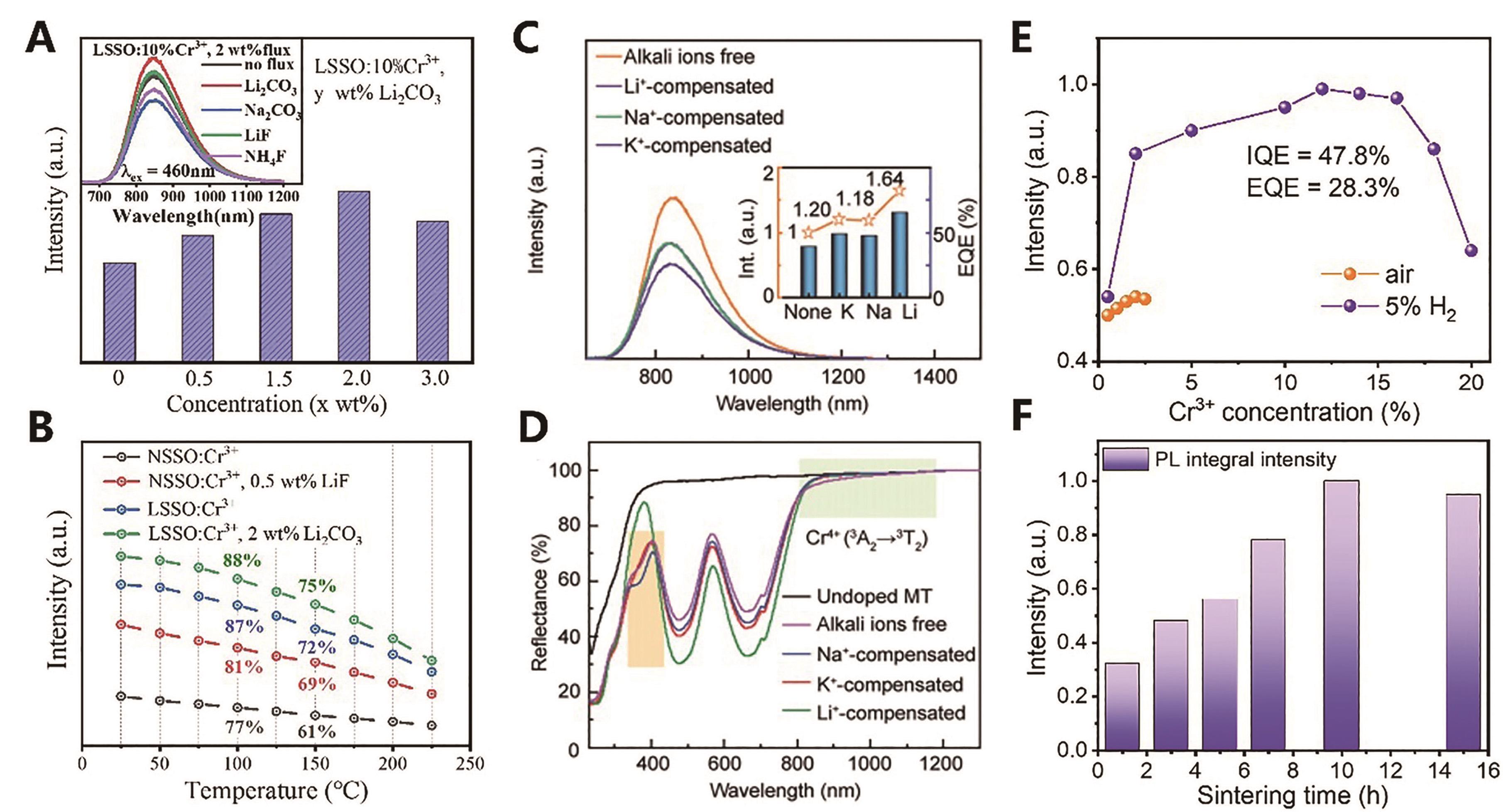
Fig.6 (A) Relative PL intensities of LiScSi2O6∶10%Cr3+,y% (mass percent) Li2CO3. The inset shows relative PL intensities of the LiScSi2O6∶10%Cr3+ with different fluxes[34]?; (B) Relative PL intensities of LiScSi2O6∶Cr3+ and NaScSi2O6∶Cr3+ at different temperatures with and without fluxes[34]; (C) PL spectra of Mg4Ta2O9∶3%Cr3+ and Mg4Ta2O9∶3%Cr3+,M+ (M=K, Na, and Li). The inset shows relative PL intensities and EQE[51]?; (D) Diffuse reflectance spectra of Mg4Ta2O9, Mg4Ta2O9∶3%Cr3+ and Mg4Ta2O9∶3%Cr3+,M+ (M=K, Na, and Li)[51]; (E) PL intensities for LiGaP2O7∶Cr3+ in air and 5% H2 atmosphere[13]?; (F) PL intensities for LiGaP2O7∶Cr3+ at different sintering times[13]
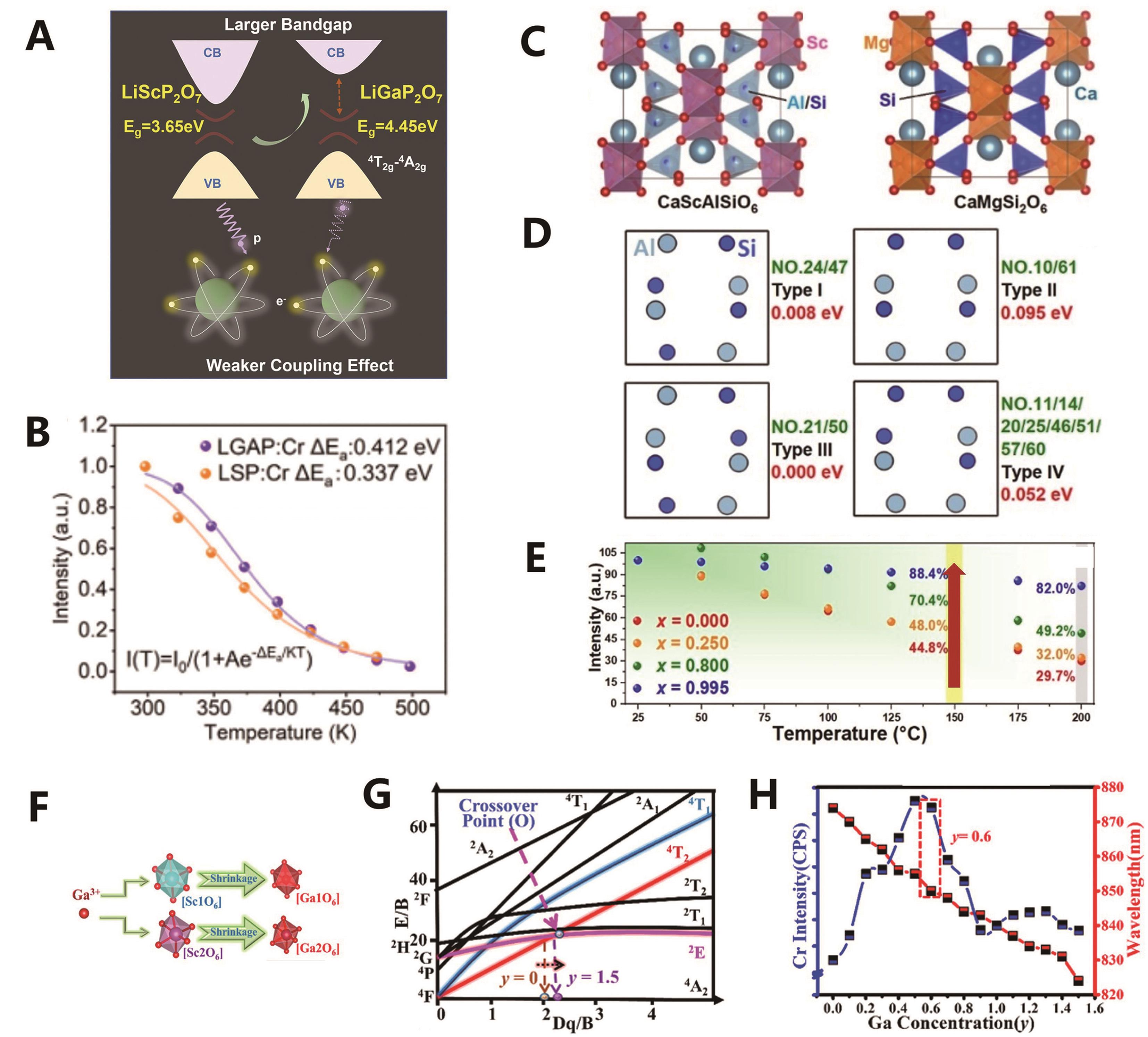
Fig.7 (A) Schematic diagrams of the bandgaps of the LiScP2O7 and LiGaP2O7 host;(B) Temperature-dependent integrated PL intensity and the fitting curves based on Arrhenius formula of LiScP2O7∶Cr3+ and LiGaP2O7∶Cr3+[13]; (C) Crystal structures of CaScAlSiO6 and CaMgSi2O6[46]; (D) The relative total energies of four types of the stable local structures of CaScAlSiO6 calculated by DFT[46]; (E) Integrated emission intensities of CaSc0.995-x MgAl1-x Si1+x O6∶0.5%Cr3+ (x=0, 0.25, 0.8, 0.995) at different temperatures[46]?; (F) Schematic diagrams of Ga3+ replacing Sc3+[28]; (G) Tanabe-Sugano diagram of Cr3+[28]; (H) The emission intensities and peak wavelengths of LaSc2.93-y Ga y (BO3)4∶0.07Cr3+ (0≤y≤1.5)[28]

Fig.8 (A) Energy-level diagram and energy transfer process form Cr3+ to Yb3+[52]; (B) PL spectra of LiGaP2O7∶12%Cr3+ and LiGaP2O7∶12%Cr3+,3.5%Yb3+[52]; (C) PL intensities of Cr3+ and Yb3+ in Lu0.2Sc0.8BO3∶Cr3+,yYb3+ and the ratio of Yb3+/Cr3+[24]; (D) Normalized integrated intensities of LiScSi2O6∶6%Cr3+,14%Yb3+ and LiScSi2O6∶6%Cr3+ and fitting curve based on Arrhenius formula[32]
| 1 | FENG X, LIN L T, DUAN R, et al. Transition metal ion activated near-infrared luminescent materials[J]. Prog Mater Sci, 2022, 129: 100973. |
| 2 | LIU G C, XIA Z G. Modulation of thermally stable photoluminescence in Cr3+-based near-infrared phosphors[J]. J Phys Chem Lett, 2022, 13: 5001-5008. |
| 3 | JIN S L, LI R F, HUANG H, et al. Compact ultrabroadband light-emitting diodes based on lanthanide doped lead-free double perovskites[J]. Light: Sci Appl, 2022, 11: 52. |
| 4 | LI D Y, HU Z W, ZHANG H Q, et al. A through-intact-skull (TIS) chronic window technique for cortical structure and function observation in mice[J]. eLight, 2022, 2: 15. |
| 5 | JIN Y, ZHOU Z, RAN R X, et al. Broadband NIR phosphor Ca2LuScAl2Si2O12∶Cr3+ for NIR LED applications[J]. Adv Opt Mater, 2022: 2202049. |
| 6 | 王长建, 乔旭升, 樊先平. 蓝光 LED 激发 Cr3+掺杂宽带近红外荧光粉研究进展[J]. 发光学报, 2022, 43(12): 1855-1870. |
| WANG C J, QIAO X S, FAN X P. Research progress on blue LED excited Cr3+ doped phosphors with broad-band near-infrared luminescence[J]. Chin J Lumin, 2022, 43(12): 1855-1870. | |
| 7 | FANG M H, BAO Z, HUANG W T, et al. Evolutionary generation of phosphor materials and their progress in future applications for light-emitting diodes[J]. Chem Rev, 2022, 122: 11474-11513. |
| 8 | ZHAO F Y, SONG Z, LIU Q L. Advances in chromium-activated phosphors for near-infrared light sources[J]. Laser Photon Rev, 2022: 2200380. |
| 9 | HUANG D C, ZHU H M, DENG Z H, et al. A highly efficient and thermally stable broadband Cr3+-activated double borate phosphor for near-infrared light-emitting diodes[J]. J Mater Chem C, 2021, 9: 164-172. |
| 10 | XIANG J M, ZHOU X, ZHAO X Q, et al. Ab initio site-selective occupancy and luminescence enhancement in broadband NIR emitting phosphor Mg7Ga2GeO12∶Cr3+[J]. Laser Photon Rev, 2023, 17: 2200965. |
| 11 | 张亮亮, 张家骅, 郝振东, 等. Cr3+掺杂的宽带近红外荧光粉及其研究进展[J]. 发光学报, 2019, 40(12): 1449-1459. |
| ZHANG L L, ZHANG J H, HAO Z D, et al. Recent progress on Cr3+ doped broad band NIR phosphors[J]. Chin J Lumin, 2019, 40(12): 1449-1459. | |
| 12 | JIA Z W, YUAN C X, LIU Y F, et al. Strategies to approach high performance in Cr3+-doped phosphors for high power NIR-LED light sources[J]. Light: Sci Appl, 2020, 9: 86. |
| 13 | YUAN C X, LI R Y, LIU Y F, et al. Efficient and broadband LiGaP2O7∶Cr3+ phosphors for smart near-infrared light-emitting diodes[J]. Laser Photonics Rev, 2021, 15(11): 2100227. |
| 14 | YAO L Q, SHAO Q Y, HAN S Y, et al. Enhancing near-infrared photoluminescence intensity and spectral properties in Yb3+ codoped LiScP2O7∶Cr3+[J]. Chem Mater, 2020, 32(6): 2430-2439. |
| 15 | ZHANG H S, ZHONG J Y, ZHANG X L, et al. Achieving an ultra-broadband infrared emission through efficient energy transfer in LiInP2O7∶ Cr3+,Yb3+ phosphor[J]. J Alloy Compd, 2021, 894: 162386. |
| 16 | ZHANG H S, LI C J, ZHONG J Y, et al. Thermally robust broadband near-infrared luminescence in the NaGaP2O7∶Cr3+ phosphor[J]. ACS Appl Opt Mater, 2023, 1: 85-93. |
| 17 | ZENG L W, ZHONG J Y, LI C J, et al. Broadband near-infrared emission in the NaInP2O7∶Cr3+ phosphor for light-emitting-diode applications[J]. J Lumin, 2022, 247: 118909. |
| 18 | ZHANG H S, ZHONG J Y, DU F, et al. Efficient and thermally stable broad-band near-infrared emission in a KAlP2O7∶Cr3+ phosphor for nondestructive examination[J]. ACS Appl Mater Interfaces, 2022, 14(9): 11663-11671. |
| 19 | ZHONG J Y, LI C J, ZHAO W R, et al. Accessing high-power near-Infrared spectroscopy using Cr3+-substituted metal phosphate phosphors[J]. Chem Mater, 2022, 34(1): 337-344. |
| 20 | ZHANG H S, ZHONG J Y, LI C J, et al. Broadband near-infrared luminescence in the NaAlP2O7∶Cr3+ phosphor for spectroscopy applications[J]. J Lumin, 2022, 251: 119211. |
| 21 | ZHANG X Z, DAI P P, WEN D W. Ultra-broadband of up to 200 nm near-infrared phosphors based on one-site occupation strategy for multipurpose applications in light-emitting diodes[J]. Ceram Int, 2023, 49(3): 4881-4888. |
| 22 | 何献国, 黄得财, 宋丽平, 等. NaAlP2O7∶Cr3+荧光粉近红外发光特性[J]. 发光学报, 2022, 43(9): 1380-1389. |
| HE X G, HUANG D C, SONG L P, et al. Near-infrared photoluminescence properties of NaAlP2O7∶Cr3+ phosphor[J]. Chin J Lumin, 2022, 43(9): 1380-1389. | |
| 23 | ZHAO F Y, CAI H, ZHANG S Y, et al. Octahedron-dependent near-infrared luminescence in Cr3+-activated phosphors[J]. Mater Today Chem, 2022, 23: 100704. |
| 24 | ZHANG Y, MIAO S H, LIANG Y J, et al. Blue LED-pumped intense short-wave infrared luminescence based on Cr3+-Yb3+-co-doped phosphors[J]. Light: Sci Appl, 2022, 11(1): 136. |
| 25 | SHAO Q Y, DING H, YAO L Q, et al. Photoluminescence properties of a ScBO3∶Cr3+ phosphor and its applications for broadband near-infrared LEDs[J]. RSC Adv, 2018, 8(22): 12035-12042. |
| 26 | SUN Z S, NING Q X, ZHOU W Y, et al. Structural and spectroscopic investigation of an efficient and broadband NIR phosphor InBO3∶Cr3+ and its application in NIR pc-LEDs[J]. Ceram Int, 2021, 47(10): 13598-13603. |
| 27 | WU H Y, JIANG L H, LI K, et al. Design of broadband near-infrared Y0.57La0.72Sc2.71(BO3)4∶Cr3+ phosphors based on one-site occupation and its application in NIR light-emitting diodes[J]. J Mater Chem C, 2021, 9(35): 11761-11771. |
| 28 | GAO T Y, ZHUANG W D, LIU R H, et al. Design of a broadband NIR phosphor for security-monitoring LEDs: tunable photoluminescence properties and enhanced thermal stability[J]. Cryst Growth Des, 2020, 20(6): 3851-3860. |
| 29 | GAO T Y, ZHUANG W D, LIU R H, et al. Design and control of the luminescence in Cr3+-doped NIR phosphors via crystal field engineering[J]. J Alloy Compd, 2020, 848: 156557. |
| 30 | GAO T Y, LIU R H, LIU Y H, et al. Spectral design in Cr3+-doped NIR phosphors via crystal field modulation[J]. J Lumin, 2022, 246: 118799. |
| 31 | CHEN L, WU Y B, LIU Q, et al. Energy conversion and transfer in the luminescence of CeSc3(BO3)4∶Cr3+ phosphor[J]. Materials, 2023, 16(3): 1231. |
| 32 | LU Z W, LIU Y F, CHEN S Y Z, et al. Improved near-infrared luminescence properties of LiScSi2O6∶Cr3+,Yb3+ phosphors via efficient energy transfer[J]. ACS Appl Opt Mater, 2023, 1: 1097-1103. |
| 33 | XU X X, SHAO Q Y, YAO L Q, et al. Highly efficient and thermally stable Cr3+-activated silicate phosphors for broadband near-infrared LED applications[J]. Chem Eng J, 2020, 383: 123108. |
| 34 | YAN Y, SHANG M M, HUANG S, et al. Photoluminescence properties of AScSi2O6∶Cr3+ (A=Na and Li) phosphors with high efficiency and thermal stability for near-infrared phosphor-converted light-emitting diode light sources[J]. ACS Appl Mater Interfaces, 2022, 14: 8179-8190. |
| 35 | LIU G C, MOLOKEEV M S, XIA Z G. Structural rigidity control toward Cr3+-based broadband near-infrared luminescence with enhanced thermal stability[J]. Chem Mater, 2022, 34(3): 1376-1384. |
| 36 | FANG L M, HAO Z D, ZHANG L L, et al. Cr3+-doped sbroadband near infrared diopside phosphor for NIR pc-LED[J]. Mater Res Bull, 2022, 149: 111725. |
| 37 | LIU T Y, CAI H, MAO N, et al. Efficient near-infrared pyroxene phosphor LiInGe2O6∶Cr3+ for NIR spectroscopy application[J]. J Am Ceram Soc, 2021, 104(9): 4577-4584. |
| 38 | CHEN X H, SONG E H, ZHOU Y Y, et al. Distorted octahedral site occupation-induced high-efficiency broadband near-infrared emission in LiScGe2O6∶Cr3+ phosphor[J]. J Mater Chem C, 2021, 9(39): 13640-13646. |
| 39 | ZHOU X F, GENG W Y, LI J Y, et al. An ultraviolet-visible and near-infrared-responded broadband NIR phosphor and its NIR spectroscopy application[J]. Adv Opt Mater, 2020, 8(8): 1902003. |
| 40 | ZHOU W Y, LUO J B, FAN J Q, et al. Luminescent properties and LED application of broadband near-infrared emitting NaInGe2O6∶Cr3+ phosphors[J]. Ceram Int, 2021, 47(18): 25343-25349. |
| 41 | LIU H Z, ZHAO F Y, CAI H, et al. Consequence of optimal bonding on cation ordering and enhanced near-infrared luminescence in Cr3+-doped pyroxene oxides[J]. J Mater Chem C, 2022, 10(24): 9232-9240. |
| 42 | ZHANG X G, CHEN X, ZHOU C, et al. Spectral engineering and thermometric performance of LiIn(Si2- xGex)O6∶Cr3+ phosphor for multi-mode NIR thermometry[J]. Ceram Int, 2022, 48(13): 19484-19491. |
| 43 | FANG L M, ZHANG L L, WU H, et al. Efficient broadband near-infrared CaMgGe2O6∶Cr3+ phosphor for pc-LED[J]. Inorg Chem, 2022, 61(23): 8815-8822. |
| 44 | FAN J Q, ZHOU W Y, ZHANG J L, et al. A novel efficient broadband near-infrared phosphor LiGaGe2O6∶Cr3+ with EQE enhancement and spectral tuning by Sc3+-Ga3+ substitution for NIR pc-LED application[J]. Inorg Chem Front, 2023, 10(2): 511-521. |
| 45 | FAN J Q, AI Y C, ZHOU W Y, et al. NIR emission spectral engineering in NaSc(Si,Ge)2O6∶Cr3+ solid-solution phosphors via crystal field regulation[J]. J Lumin, 2022, 247: 118887. |
| 46 | WEN D W, LIU H M, GUO Y, et al. Disorder-order conversion-induced enhancement of thermal stability of pyroxene near-infrared phosphors for light-emitting diodes[J]. Angew Chem, 2022, 61(28): e202204411. |
| 47 | ZHONG J Y, ZHUO Y, DU F, et al. Efficient broadband near-infrared emission in the GaTaO4∶Cr3+ phosphor[J]. Adv Opt Mater, 2021, 10(2): 2101800. |
| 48 | LIN Q M, WANG Q, LIAO M, et al. Trivalent chromium ions doped fluorides with both broad emission bandwidth and excellent luminescence thermal stability[J]. ACS Appl Mater Interfaces, 2021, 13(15): 18274-18282. |
| 49 | LIU Y, HE S, WU D, et al. Broadband NIR garnet phosphors with improved thermal stability via energy transfer[J]. ACS Appl Electron Mater, 2022, 4(2): 643-650. |
| 50 | ZENG H T, ZHOU T L, WANG L, et al. Two-site occupation for exploring ultra-broadband near-infrared phosphor double-perovskite La2MgZrO6∶Cr3+[J]. Chem Mater, 2019, 31(14): 5245-5253. |
| 51 | WANG S W, PANG R, TAN T, et al. Achieving high quantum efficiency broadband NIR Mg4Ta2O9∶Cr3+ phosphor through lithium-ion compensation[J]. Adv Mater, 2023, 35(22): 2300124. |
| 52 | LU Z W, CHEN S Y Z, LIU Y F, et al. LiGaP2O7∶Cr3+,Yb3+ phosphors for broadband NIR LEDs toward multiple applications[J]. J Alloy Compd, 2023, 956: 170311. |
| [1] | Zhi-Peng DU, Yang ZHOU, San-Gen ZHAO. Synthesis, Crystal Structure and Birefringence Properties of Silver Cluster Compound Ag3B6O10I [J]. Chinese Journal of Applied Chemistry, 2023, 40(2): 229-235. |
| [2] | Shu-Hua HOU, Shi-Qi LI, Li-Jun TANG. Synthesis of a Novel Water-Soluble Rhodamine-Based Fluorescent Probe and Its Selective Detection of Free Trivalent Ions [J]. Chinese Journal of Applied Chemistry, 2022, 39(02): 241-246. |
| [3] | WEN Guang-Ming, JIAO Ting, DU Xiao-Yan, LI Zhong-Ping. Preparation and Application of Sulfur and Nitrogen Co-doped Carbon Quantum Dots [J]. Chinese Journal of Applied Chemistry, 2021, 38(6): 722-730. |
| [4] | TANG Anping1,2*, LIU Lihua1,2, XU Guorong1,2, SHEN Jie1, LING Yuling1,2. Progress in Borate Electrode Materials for Lithium Ion Batteries [J]. Chinese Journal of Applied Chemistry, 2012, 29(11): 1221-1230. |
| [5] | Zhang Lanying, An Shengji, Shang Qingkun, Zhang Guo, Wu Gongsheng, Tang Xinyi. ADSORBABILITY OF PRODUCTS OF STARCH-g-PGMA WITH GLYCINE ON Au,Pd,Cr,AND Cd IONS [J]. Chinese Journal of Applied Chemistry, 1991, 0(6): 95-97. |
| [6] | Zhuang Yunlong, Qi Deyao. THE RESPONSE CHARACTERISTICS OF LITHIUM ION-SELECTIVE MICROELECTRODE IN BIOLOGICAL BODY FLUIDS [J]. Chinese Journal of Applied Chemistry, 1989, 0(2): 63-66. |
| Viewed | ||||||
|
Full text |
|
|||||
|
Abstract |
|
|||||
